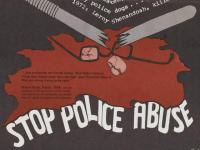This blog was written by Lynn Darby, a Cultural Fieldwork Intern from Temple University’s School of Education.
So what is counterculture?
A broad term, “counterculture” often refers to groups of individuals who broke through societal norms during the “Cold War Era” primarily through the 50s, 60s, and 70s in order to enact social change. One of the biggest elements of the counterculture back then was the Civil Rights Movement, and if you’re looking for an alternative lens to study it, look no further than HSP’s “Broadsides, posters, and ephemera relating to Black Power, Civil Rights, and Black Communism movements, 1960-1975”. This collection is composed of different forms of propaganda used by the NAACP and other black civil rights groups to promote their agenda of civil rights, endorsing Black politicians running for office, encouraging other African Americans to vote, and even communism. The “Broadsides, posters, and ephemera relating to Black Power, Civil Rights, and Black Communism movements, 1960-1975” collection features some very vintage Civil Rights Era propaganda that would be a great supplement in any lesson relating to such subjects.
How do I use it?
One approach when teaching about the Civil Rights Movement using this resource would be to partner students up with each other and distribute the different forms of propaganda evenly among the groups for a worksheet analysis. Ask the students to look over the various forms of propaganda and come up with what they think were the biggest issues on the overall agenda of Black activists at the time and why. After each group has had time to look everything over, have them come up to the front of the class to share their responses and argue their points. This would be a great anticipatory set when preparing to teach about the Civil Rights Movement as a whole as it utilizes primary sources and promotes inquiry-based thinking to give students a direct feel for what people were advocating for back then and draw their own conclusions on these arguments.
How else?
If you’re looking for another way to incorporate “Broadsides, posters, and ephemera relating to Black Power, Civil Rights, and Black Communism movements, 1960-1975” into the classroom and might not be teaching about the Civil Rights Movement directly, but possibly just any aspect of American life through the 50s-70s, these sources could still be of use. They offer a unique look at how civilian life, specifically that of a marginalized group, was during the period and how the group advocated for itself.

